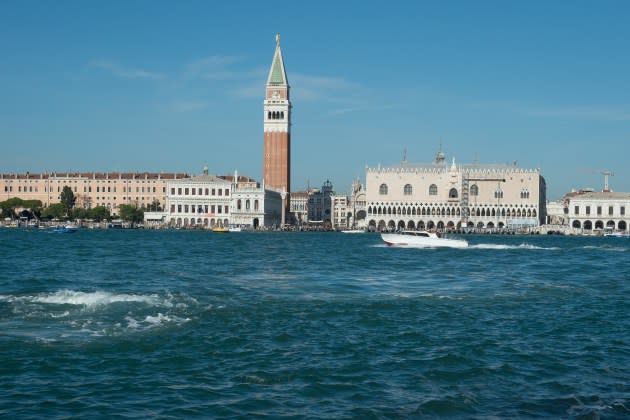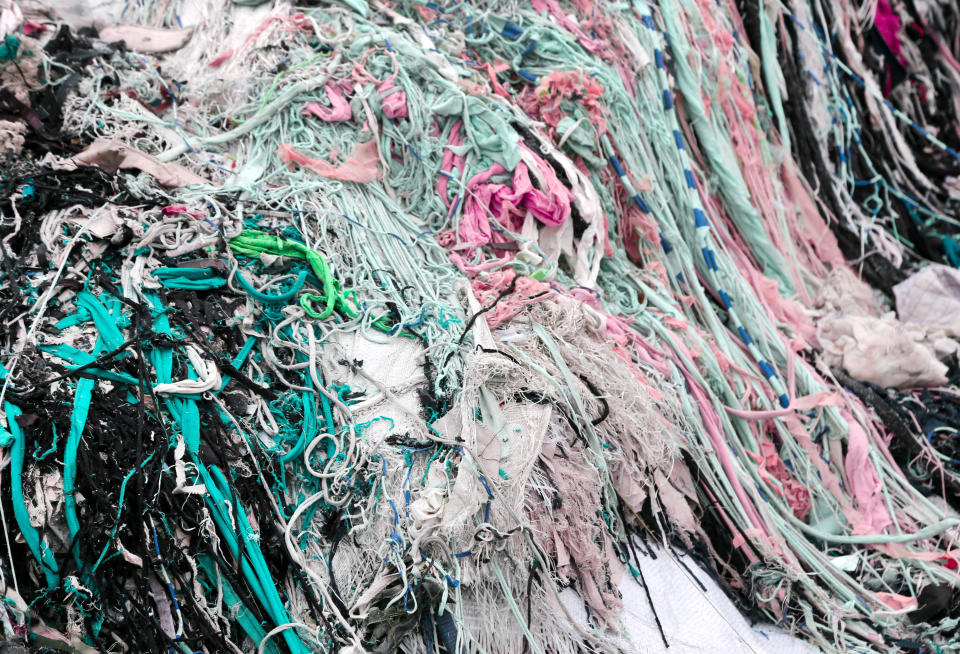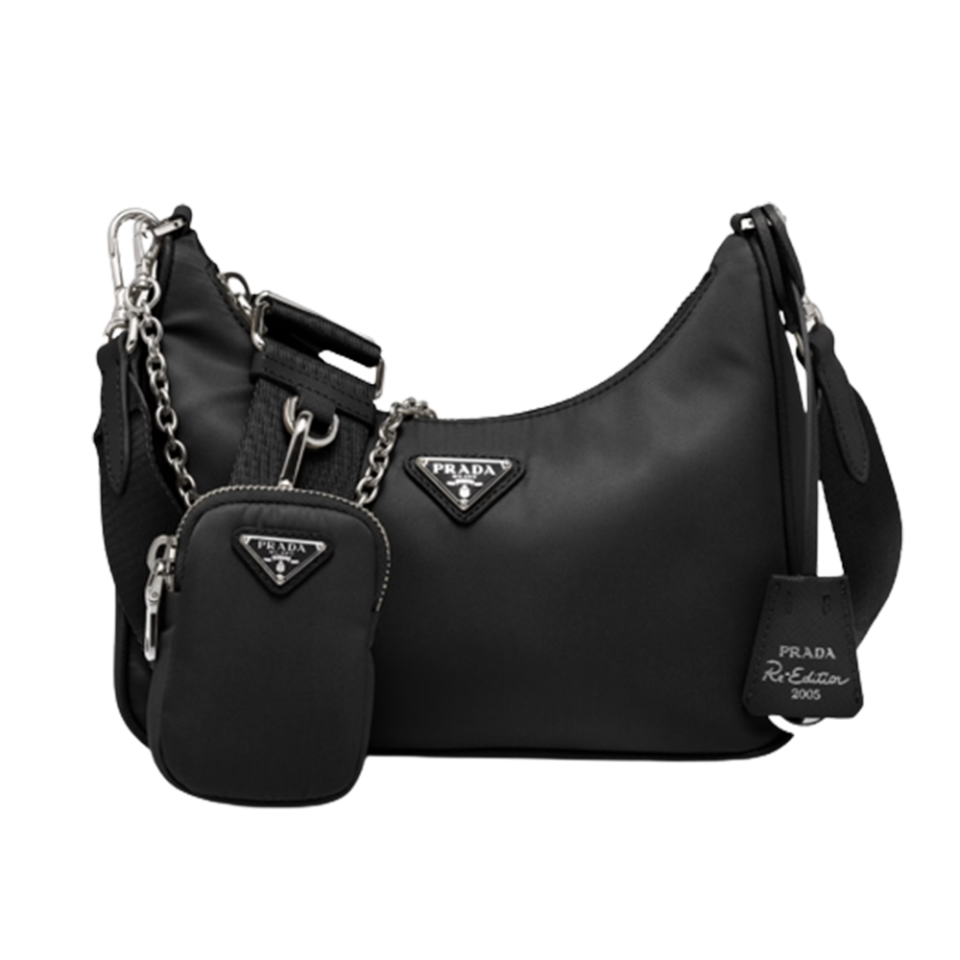Fashion Sustainability Journey’s Challenges: Consumers, Laws, Global South

VENICE, Italy — Sustainability is mostly a tale of two worlds, even as the fashion sector embraced the transformation years ago. Clashing forces coexist: The global South and the exploitative Western world; consumer behavior misaligned with their professed beliefs; the advanced value ecosystems, mostly serving the luxury and high-end sectors, versus the traditional supply chain.
The sophomore, two-day edition of the Venice Sustainable Fashion Forum held here at the Fondazione Cini depicted a scenario perhaps less nebulous than in the past but equally challenging.
More from WWD
Prada CEO Gianfranco D'Attis on Building a Brand of Substance
Maya Hawke, Kim Tae-Ri Among Actors Fronting Prada Holiday Ad Campaign
In opening remarks, Sistema Moda Italia, or SMI, president Sergio Tamborini, among the organizers of the event alongside Confindustria Veneto Est and consultancy The European House Ambrosetti, said that it’s about time to move “from an economy of abundance to an economy of ‘enough-ness,’” meaning that customers need to be educated to make thoughtful purchases of quality items and companies need to embed circularity and innovation. “Talking about ‘enough-ness’ with a positive attitude is an opportunity,” he offered.
A study by Ambrosetti did seem to provide encouraging signs, noting how the assessed panel advanced its ESG performance by 17 percent in the year since the previous report, a positive step forward, according to Carlo Cici, partner and head of sustainability practices at the consultancy. However, the best-in-class firm, whose name was not disclosed, only meets 70 percent of the desirable criteria.
The panel assessed 2,800 European companies on their margins, 374 Italian businesses through a questionnaire, the 100 biggest European enterprises analyzing their sustainability efforts and included to define a benchmark, as well as 32 of the most important global retailers.
“The sector is extremely late; other industries started the journey 20 years ago,” said Flavio Sciuccati, senior partner and director of the global fashion unit at The European House — Ambrosetti.
Consumers May Not Be as Ready for Full-on Sustainability as One Thinks
Is climate change — a hotly debated topic — the Trojan horse to convince customers to reevaluate their fashion shopping habits, at a time when there are few signs of a slowdown in demand for fast-fashion products?
Over the years studies have revealed consumers are a driving force in fostering a sustainability transition. Yet global inflation and reduced spending power result in a more complex landscape.
“Climate change is a topic for wise people. Young people have generally thought about the present and far less about the future,” said Dario Fabbri, a geopolitical analyst. “We do perceive climate change as being a youth’s topic just because Western youth mostly live in countries with an older population. On the contrary, take, say, young Iranians, they do care about living in a more laical state and getting more power, not [tackling] climate change, which is a paradox because they are far more exposed to it than Western youth.”
From a fashion standpoint it means the bulk of its current and prospective customers — global Gen Zers and Millennials, alike — may not be as inclined to shoulder premium prices for sustainability products. What’s more, the study says, consumers have the impression there are too few sustainable options on the market, even though 58 percent of them are interested in green fashion.
“There’s a gap between attitude and action; humans are very contradictory,” said Shakaila Forbes-Bell, founder and chief executive officer of the Fashion Is Psychology platform. “Why are we even buying these clothes? Because it makes us happy and that’s why fast fashion is accelerating right now. People are struggling in the world, even in the happiest of places, and shopping is a dopamine booster, there’s disconnect between the things that we’re purchasing and the [value of the] shopping experience per se, just because the latter promotes well-being.”
“The forces driving consciousness so far have been external to the consumer market and more triggered by the financial world,” agreed Luca Solca, managing director, luxury goods at Sanford C. Bernstein.
“A lot of people buy clothes to enjoy shopping and see other people at shopping malls, and I think we should work to identify and promote a cultural sophistication and entertainment aspect [to shopping] linked to the use of clothing in alternative ways,” said Stefani Micelli, professor of economics and business management at the Ca’ Foscari University of Venice, adding an Italy-specific notion to the conversation. “We need to demonstrate that Italy can promote a vision of sustainability aligned with our peculiarities. We need to try and represent sustainability as a whole from a storytelling standpoint.”

More than the doom and gloom of the climate change threat, open dialogues between fashion stakeholders are viewed as pivotal in fostering global consciousness. To be sure, after years of eco-advocates and brands warning global consumers against greenwashing, there’s a new ripple effect to the pressure the system is facing called “greenhushing.”
“There are so many companies that are not using their voice to explain what’s happening in their companies and their supply chain, how they are tackling their impact,” said Sweta Chakraborty, chief executive officer of the North America division of the “We Don’t Have Time” social media and advocacy space. “Up to 50 percent of decision making is made not necessarily on what you’re being told but the fact that they trust the person telling it.”
Proving the point, Maria Teresa Pisani, economic policy officer at the United Nations Economic Commission for Europe, or UNECE, said that according to data provided by the Council of the European Union, about 60 percent of the continent’s consumers express interest in sustainable choices but do not trust sustainability claims.
Forbes-Bell argued that sustainability messaging should be far more widespread.
“We’re just preaching to the choir; we need to make sure we communicate with people from outside the [sustainable] echo chambers. The social element that we need to stop seeing is that non-eco-inclined customers are labeled as uncool in sustainability messaging,” she said.
Ongoing Lawmaking Quagmire Shows Signs of Progress
No matter what consumers will be willing to buy into, policymakers are committed to going ahead, rapidly ramping up companies’ eco-efforts, albeit with drastically different approaches between the European Union and the U.S. The latter is focused on incentives for companies meeting some targets, as opposed to Europe’s regulation-heavy policy.
The 2050 net zero emission target set by the EU is geared toward preserving competitiveness and ensuring future prosperity, said Lisa Lang, chair of the Creative Industries Task Force at the United Nations.
“It’s a wake-up call and reality check because when regulations come there’ll be no other way than comply and survive or back out of it and shut down,” she offered.
The continent and the world are lagging behind, though.
Tatiana Molcean, executive secretary of the UNECE, and undersecretary general of the United Nations, said that only 15 percent of the SDGs targets have been achieved globally. “We’re lagging behind, we’re not even halfway through. There’s so many challenges around the world, but the [fashion] industry has a huge potential because it relates to half of the SDGs and it’s a sector that creates millions of job… it’s impactful on climate change, water and soil use,” she said.
The quantum leap the industry has yet to make is about reaching “sustainable automatism,” in the words of 2007 Nobel Peace Prize winner Riccardo Valentini, currently a member of the Intergovernmental Panel on Climate Change.
That’s probably when different driving forces — consumer interests, laws and business advantages — will eventually converge. The three-pronged approach is the only way all players involved will buy into sustainability.
“I strongly believe we can overhaul the fashion sector. I worked in different industries where people said it was impossible to pursue clean energy and it’s happening, it happened. It needs to be done in fashion, too, it’s time for everyone to take action,” said We Don’t Have Time’s Chakraborty.
“We should get rid of words such as framework, white paper, KPI from task forces,” said Federico Marchetti, currently chair of King Charles’s Fashion Taskforce. “Let’s talk about action, we should act now! For sustainability to become an automatism we need to all become activists.”

At the lawmaking level, the EU Strategy for Sustainable and Circular Textiles first introduced in 2022 is expected to define a common ground. The strategy covers eco-design principles, logistics, the Digital Product Passport and the extended producer responsibility, or EPR — a framework that sets accountability terms on fabric-makers for textile waste — among other pressing issues.
Although its implementation has been slow, it’s widely believed that by 2025 both eco-design and the EPR will come into effect, the latter sooner rather than later.
“The entire European community is taking the challenge to another level but there are so many hurdles, including setting a level playing field for Made in Europe products versus imported goods,” said Alberto Paccanelli, president of the European Apparel and Textile Confederation, or Euratex.
“We’re aiming to switch the fashion business model from linear to circular, but it needs to be done with periodical ‘competitivity checks,’ ensuring that the competitiveness of the European industry remains untouched or even improves. We’re adopting rules that will have a cost and impact on the continent’s supply chain so we need to make sure,” he added, noting the association is negotiating a “transition pathway” with policymakers in Brussels.
Delving deeper into the textile association’s proposals, Mauro Scalia, director, sustainable businesses at Euratex, said he sees three key principles informing the eco-design pledge, including durability, reuse and recycled materials, and that the association is aiming for the Digital Product Passport to be used for market watchdog purposes, too.
“The transition is going to disrupt low-quality product makers, while we expect it to have less of an impact on middle- and high-end companies. It’s going to reorganize products on the European market and promote quality and sustainability,” Scalia said.
In addition to positioning, companies’ scale plays a fundamental role when it comes to boosting change and complying with stringent regulations. This is particularly true for the Italian fashion sector made up of more than 50,000 small-and-medium-sized enterprises, but also for the European fashion manufacturing system.
“For SMEs compliance is very expensive so there needs to be progression and proportionality, which I’m sure the European lawmakers are accounting for,” said Pisani.
“The transition needs to be fair and avoid that any entity is neglected,” echoed Alessandra Moretti, an Italian member of the European Parliament.
As the industry awaits European lawmakers to promulgate policies, and individual countries to align with those, two open topics emerged as equally pressing at the two-day forum: how the EU will legislate in terms of due diligence and traceability across the value chain and how it will manage law enforcement.
On the former front, panelists agreed, it’s hard to imagine preserving the continent’s industrial competitiveness if products and supplies coming from outside Europe won’t be subject to the same regulations.
Global South and Value Ecosystems, an Unbalanced Pair
As sustainability was becoming a pressing topic — as a matter of business survival and advantage, access to funding and a grip on consumer trust — textile and fashion businesses in Europe, and particularly in Italy, have progressively realized how collaboration is pivotal.
“Sustainability is expensive and if we don’t spread its cost across the supply chain it easily turns into an unsustainable journey,” said Ercole Botto Poala, CEO of woolen mill Reda and president of Confindustria Moda. “Up until now sustainability was a reputational issue for brand and a cost issue for manufacturers,” he added.
In more ways than one, Italy’s fashion system has proven to be inventive, with conglomerates grouping supplier companies being formed over the past 10 years. Among them, Gruppo Florence is a 670-million-euro group currently comprising 26 manufacturers that is on track to acquire seven more by the end of the years, according to CEO Attila Kiss, while Holding Industriale, founded in 2008 by Claudio Rovere with a 12-enterprise portfolio, generated 350 million euros in 2023 sales.
Fashion brands have snatched up stakes in their suppliers — take for one Brunello Cucinelli and Chanel teaming on a deal to acquire a minority interest in yarnmaker Cariaggi — or simply fostered innovation by partnering with their suppliers, as was the case for Prada’s ReNylon project that involved Limonta and Aquafil. The latter project’s next step is to conduct a lifecycle assessment of the recycled nylon fabric, said Chiara Morelli, sustainability director and supply chain expert at Prada Group.
“Not all supply chains are equal, but all collaborations can lead to new visions on different materials and pipelines,” Morelli said.
“Suppliers are becoming partners, it’s no longer a traditional supplier-company relationship,” echoed Rossella Ravagli, sustainability director at Giorgio Armani.

Collaboration and cross-pollination have led Italy — and to a certain extent Europe — to becoming home to virtuous value ecosystems.
However, in the current globalized scenario, reliance on suppliers from outside the continent entails more challenges to the transition and, some speakers agreed, a wakeup call to the Western world on how the collaborative mindset should be shared with the Global South, where environmental impact and social issues go even further hand in hand.
The Ambrosetti study estimated that European Union’s consumers produce roughly 5.2 million tons of textile waste per year, or 26 billion garments. Progresses have been made in the reuse and recycling fields but it’s still a long way to go. Out of 35 garments discarded by European citizen each year, only three are repaired and one is channeled into the second-hand market.
“It’s the era of shared responsibility, it’s no longer a transaction between suppliers and sub-suppliers, it’s shared responsibility to audit risks [across the supply chain] and manage them,” said Auret Van Herdeen, CEO and founder of Equiception, a consultancy that specializes in sustainable supply chains, corporate social responsibility and workers’ rights
The ecological compromise “was and is a consequence of social issues, each [developing] country has different scenarios, but one thing’s in common: we treat them exploitatively and for them it’s about economic survival. If you are not in the social and economic conditions to have the luxury to think of anything else than economic survival than ecological compromise is the only solution,” said Matteo Ward, founder of eco-minded label Wråd and a sustainability advocate.
That’s where the Western world should chip in, fostering progress globally.
According to Chloe Asaam, manager of Ghana operations at The OR Foundation, a U.S.- and Ghana-based public charity promoting justice-led circular economy, her country is the final destination of discarded fashion, which comes with too little investments and money. “It’s plain simple. If you find a way to move tons of [fashion] pieces from one end of the world to the other there must be a way to move money as well,” she said.
“We keep talking about the dramatic situation of the global apparel industry but that’s the byproduct of choices made 20 years ago when we were asked to meet consumers’ demand for ‘democratic fashion.’ Now we realize it produced an impact,” said Botto Paola.
“The current era calls for inter-independence, meaning conscious entrepreneurship,” said sociologist and professor at the Catholic University of Milan Mauro Magatti.
“It’s a lot of change but that’s what the sector is about…these are chances for the sector to leap ahead. Isn’t fashion all about change?” questioned, provocatively, Virginijus Sinkevičius, commissioner, DG environment at the European Union Commission.
Best of WWD

